SHOUTcast DSP Encoder Setup Tutorial
1Prerequisites
The following softwares and components are required to start audio streaming with SHOUTcast DSP
Operating System: Windows Vista, Windows 7, Windows 8, Windows 10
Latest version of Winamp: Download
Nullsoft Shoutcast Source DSP Plug-in for Winamp: Download
Internet Access: A DSL or Cable connection to the internet is recommended for optimal performance.
To start off, please Log in to your Primcast account and you will be automatically redirected to the Control panel. Click on the "Login to Centova" button which will redirect you to the actual SHOUTcast station panel.
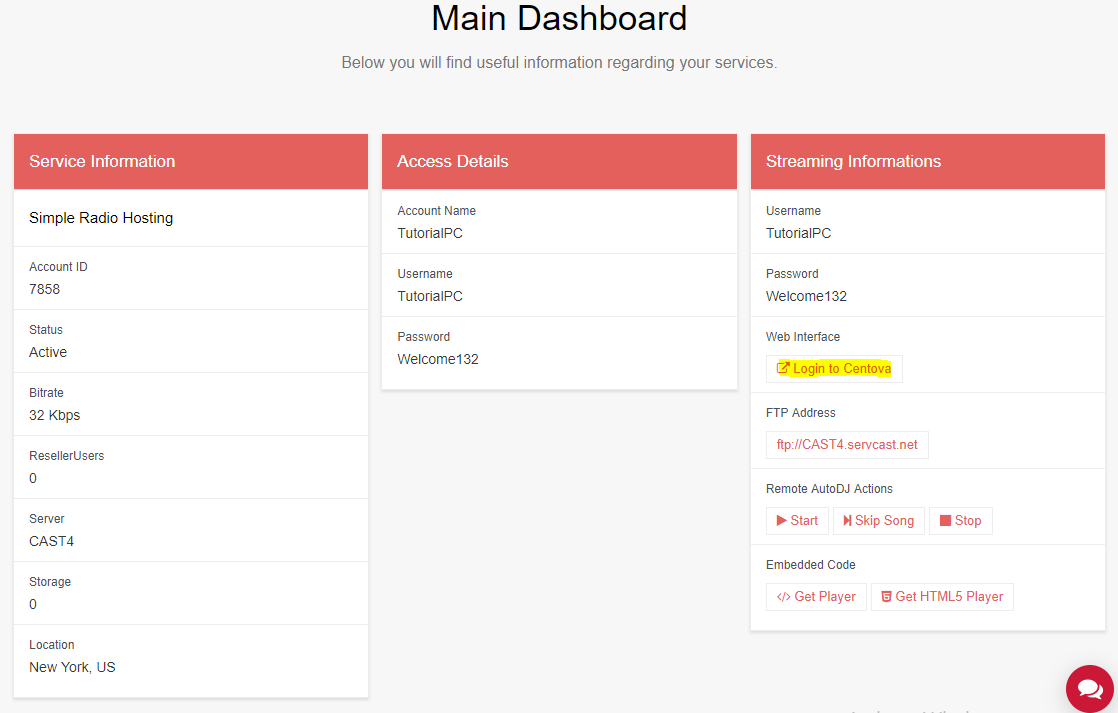
2Get the streaming info
Inside the Centova Pane, click on the Start button from the left menu to power on your SHOUTcast station then click on Quick Links so you can get the station informations.
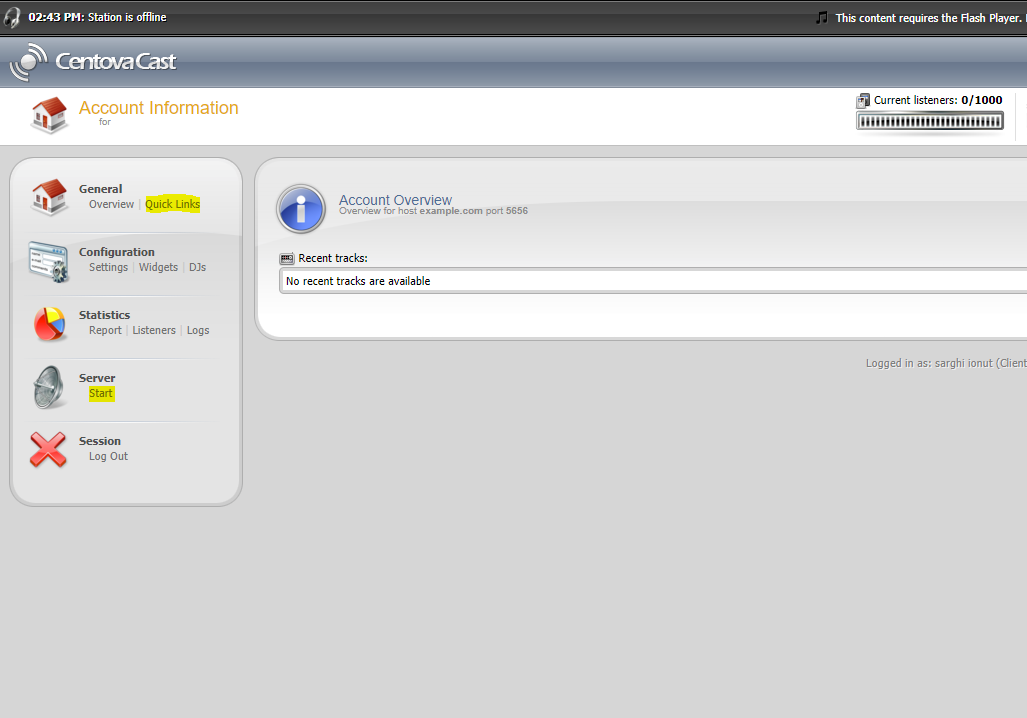
Now that you are on the Quick Links page scroll down to the Live Source Connections category and get the Server Hostname and Server Port. You will need these later when you setup your Winamp encoder.
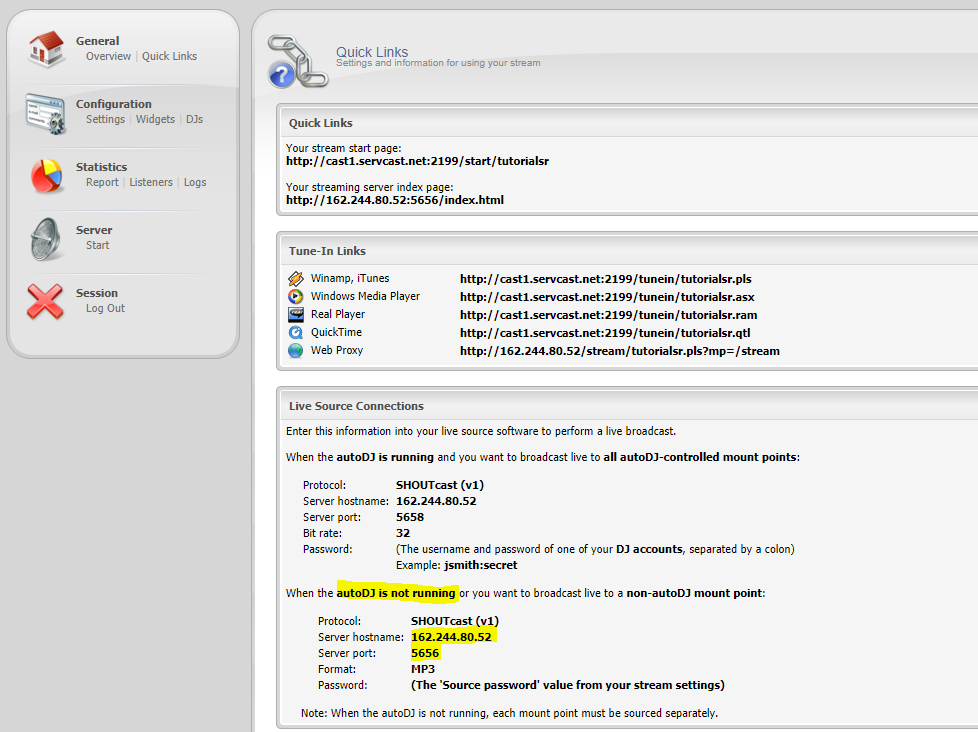
Now to retrieve the Streaming Password you need to access the Settings section of Centova Panel then click the small button near the source password field to reveal the text.
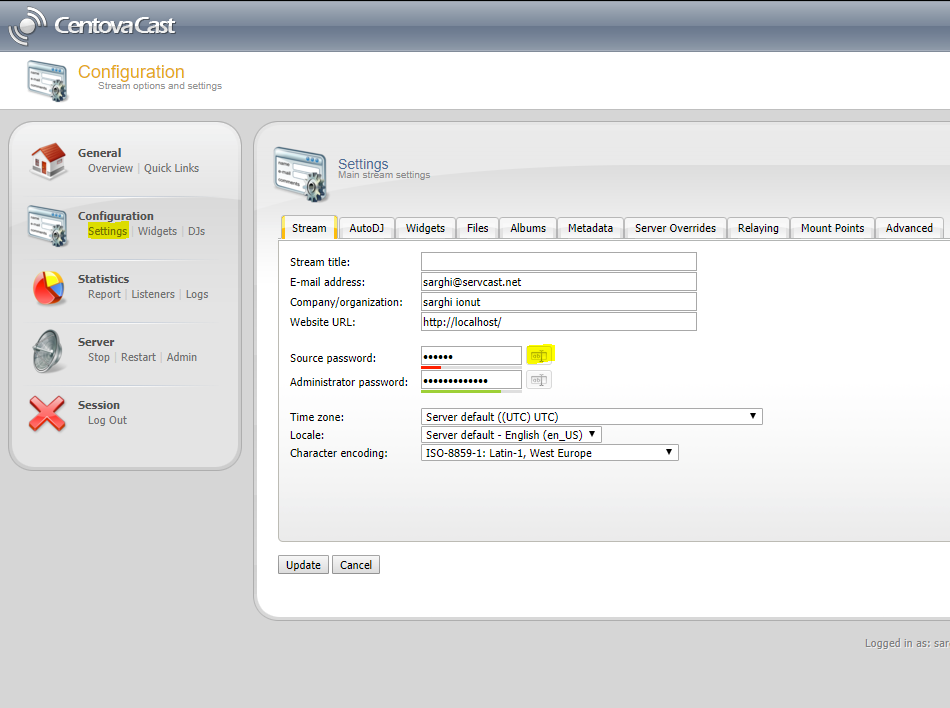
3Setup Winamp with SHOUTcast DSP
We will now setup the SHOUTcast Source to stream to your Primcast audio server.
For this step, you must know your Server Hostname, Server Port, and Streaming Password that you saved from Step 2.
Run the Winamp installer that you downloaded from Step 1 and install the software.
Run the SHOUTcast DSP installer that you downloaded from Step 1 and install the software.
Open the Winamp software from your computer's Desktop.
Press CTRL+P on your keyboard to open Preferences -> Click DSP/Effect and double click SHOUTcast Source DSP v2.3.5.
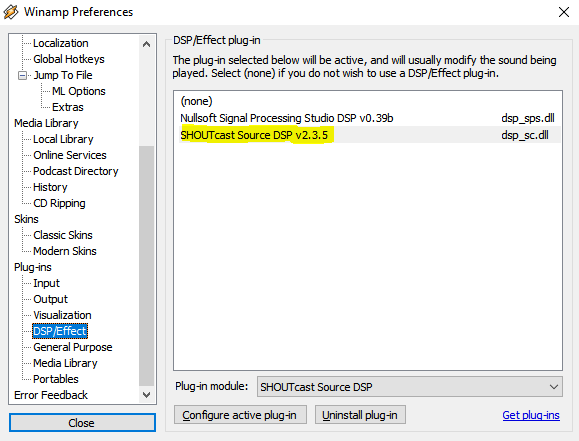
Now add the required information on the DSP page that you just opened.
Insert the Server Hostname, Port and Streaming password, make sure you leave the Username field Blank.
Under the field labeled "Address" you will need to enter the address of your Server Room server. This should not include a http:// or www prefix.
Next you need to provide the Shoutcast source with your server's port information. This should be a number entry only and entering a value other than a number will produce an error when connecting. An example of a correct port configuration would be 8000 or 1234. You should enter this information under the field called "Port".
You will also need to provide SHOUTcast Source with the valid password to your Primcast server. Enter your servers password into the field labeled "Password". Notice that the password is masked, so make sure you type carefully otherwise you will have problems connecting.
By default, the value of "Connect at Startup" is unchecked; however, if you wish to start broadcasting as soon as you load Winamp you will want to check this option. Also, by default the value "Reconnection Timeout" is set to 30 seconds. If you wish for the Shoutcast Source plug-in to attempt to reconnect to the server upon being disconnected, you should set this to 0. If you do not wish to immediately reconnect but wish to wait x number of seconds, you should set this value to the one of your choosing.
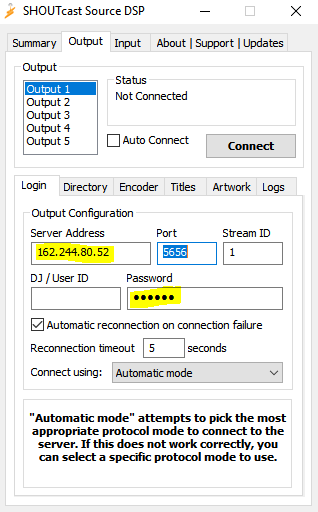
You will now need to set the Directory setting for your broadcast. The Directory setting is optional but will allow your station to be listed on the Nullsoft Shoutcast website at www.shoutcast.com.
The Directory settings allows your listeners to see what is currently playing and what the name of your station/website is.
To access the Directory configuration, click the button labeled Directory to the right of the "Connection" button.
You should now see a dialogue window that looks like the screenshot above. If you would like to make your radio station (server) public, or in other words listed on the Nullsoft Shoutcast website at www.shoutcast.com you should check the checkmark labeled "Make this server public".
Under the field labeled "Description", you should enter the title of your radio station or broadcast. An example would be "Primcast sample radio station" or "Johns Music" - this field can contain any alphanumeric entry including general punctuation (periods, semi-colons, asterisks, etc.)..
Under the field labeled "URL" you should enter the website of your radio station, your personal website, or a website that pertains to the stream itself.
Under the field labeled "Genre" you should specify what type of music or content you are streaming. For example, if you were broadcasting a live talk show you could enter in this field talk or live talk radio. If you were broadcasting a Rock show you could specify Rock and so forth.
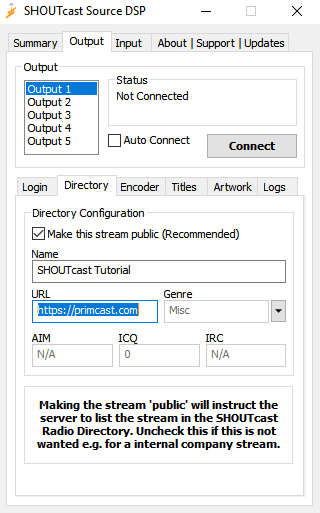
Click on the tab on the top of the Shoutcast Source called Encoder which will change the dialogue to what you see below.
The encoder configuration allows you to specify which bitrate you wish to broadcast your stream at. If you wish to make your stream available to 56k modem users, you should select 24 or 32kbps. However, if you wish to broadcast to DSL or Cable users, you should select anywhere from 64kbps to 128kbps. Broadcasting at a bitrate higher than 128kbps is not recommended as many internet users cannot receive bitrates of higher bitrates.
Choose your bitrate selection carefully, and make sure you tell your listeners what their required internet connection speed is. Notice that you also have the choice to broadcast a mono or stereo signal which should be chosen at your discretion.
Choose your bitrate selection carefully, and make sure you tell your listeners what their required internet connection speed is. Notice that you also have the choice to broadcast a mono or stereo signal which should be chosen at your discretion.
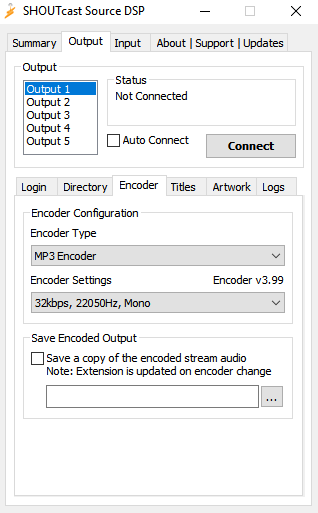
4 Setup Audio Source
Finally, you will need to setup your input to the source. Click the tab on the top of the Shoutcast Source that is labeled "Input" and you will see the following dialogue.
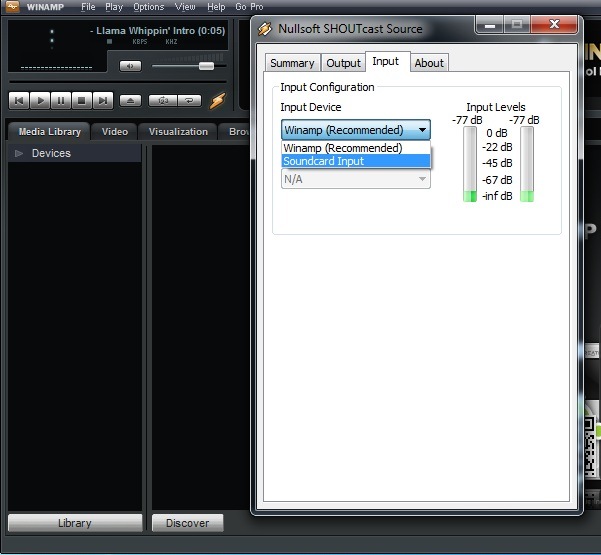
The default Input Device selected is Winamp. This option will simply broadcast whatever is playing in Winamp, without broadcasting any other sounds that may play on your computer. This setting is recommended for most users, especially those who simply want to stream a playlist of music without any other sources.
You may also choose to broadcast using a Soundcard Input, which will allow you to broadcast not only what is playing in Winamp but also any other sounds that you play on your computer along with your computer microphone. Advanced users may even want to setup a mixing board to the line input of their soundcard to broadcast a mix of music and voice. The Soundcard Input is especially popular among those using Shoutcast for an online radio station.
To use the Soundcard Input, you should first select it from the drop down menu. Notice that the Input Settings drop down menu has now become un-greyed.
For best sound quality, you should select 44100Hz, Stereo as your Input Setting.
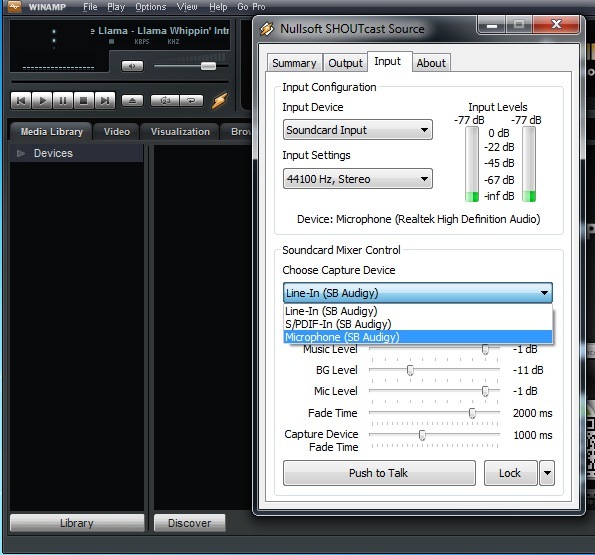
Under the Mic Input field, select which input on your sound card you will be using as your source. If you are using a standard computer microphone, you should select Microphone. If you are using a mixer board, an external CD Player, or some other form of sound that is not plugged into your Microphone input on the soundcard, you should select Line Input as your Mic Input.
You should now click the button to the right of the field labeled "Mic Input" that reads "Open Mixer". This will bring up the Windows mixer which will allow you to configure your sound card. You must make sure you have checked the option under your soundcards Recording Control labeled either "Stereo Mix, Wave Mix, What you Hear, etc.). You will need to consult your soundcards documentation if you can not find a similar option.
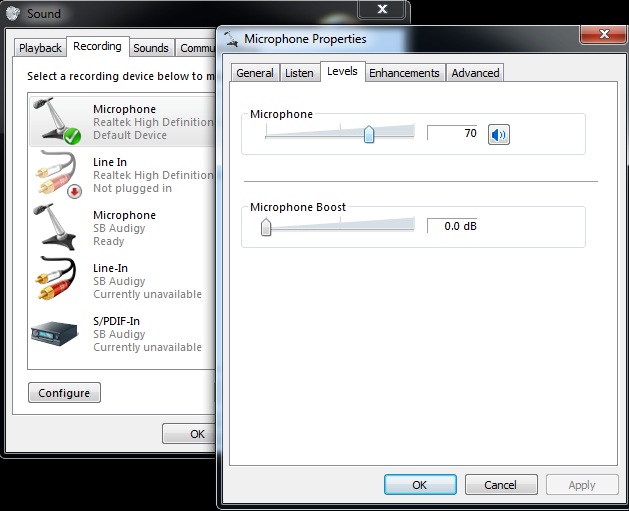
Because all soundcards are not all the same, your soundcards configuration and/or wording may be different than the one shown above. You should consult your soundcards documentation if you have problems setting this up.
After you have made this configuration, you may close Windows Mixer.
5 Listen your stream
You can now go back to your Centova Panel, access the Quick Links tab and listen your stream from Your stream start page.
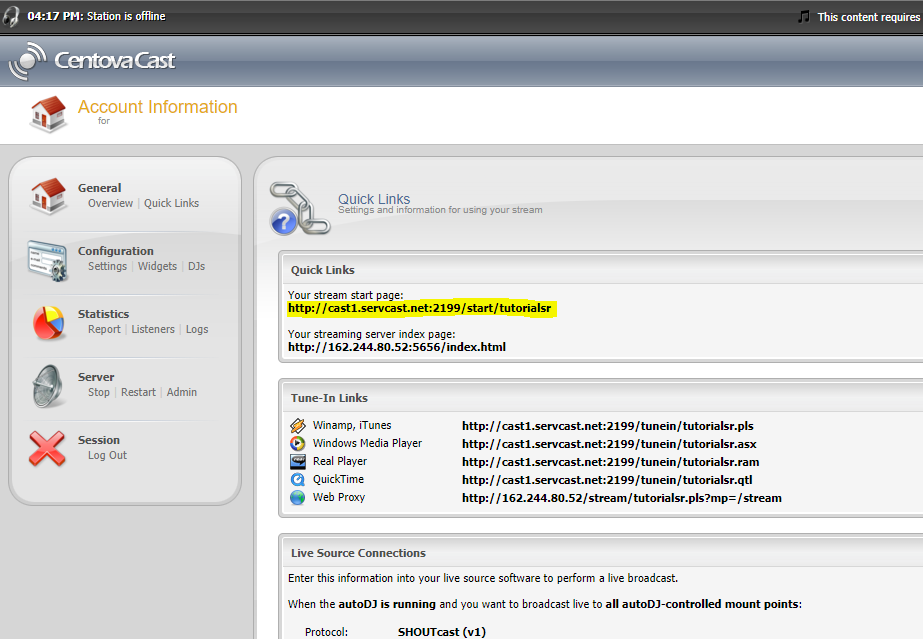
6 Congratulations!
You are now ready to use your streaming audio server and test your broadcast skills.
Happy streaming!